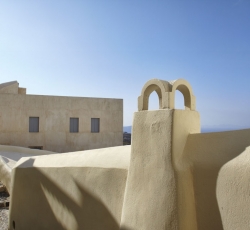Pyrgos, once the capital of Greece’s most photographed island, evokes a different Santorini. A medieval Venetian settlement that has survived earthquakes and mass tourism, Pyrgos is the closest you’ll get to experiencing island life at its most authentic. Get your hiking gear on!
You know you’re in Pyrgos as the tempo suddenly changes from the frantic activity at the port and the bustle of Fira to an unhurried, leisurely pace, punctuated only by the sounds of village elders playing backgammon at the local ouzeria and of cats mewling for crumbs off the table.
Time stands still as this majestic hamlet, perched atop the island’s most vantage point overlooks the sweep of history and natural forces that have shaped its destiny, as indeed that of Santorini.
The best way to explore Pyrgos is to hike from the main square dotted with century-old pines and charming cafes to the foothills of Profitis Ilias and up to the medieval castle. The maze-like structure of this fortified town, with its low two-storied houses and sheltered balconies, was designed to deliberately confound pirates and other invading marauders. The garrisoned hamlet had just one gate, locked at sunset, with a sinister murder-hole or fonissa, which old-timers claim was large enough to tilt a cauldron of boiling water on itinerant enemies.
This impeccably preserved settlement largely escaped the destruction that the rest of the island suffered in the 1956 earthquake. It also survived mindless construction thanks to the zealous efforts of its villagers keen on preserving its rich heritage.
Pyrgos affords a rare insight into life on Santorini before mass tourism and boasts some spectacular churches dating back to the 14th century including the recently restored Church of the Virgin Mary, handsome mansions, acclaimed gourmet destinations and iconic bars, art galleries and cafes.
For a different experience of Santorini, visit Pyrgos.










